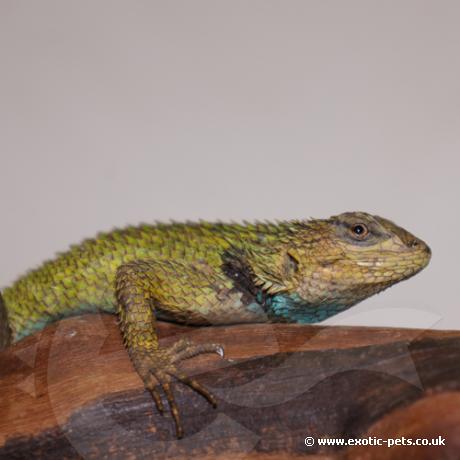

Emerald Swift get their name due to the males bright colours. They are small sized, very active and easy species to keep.
| Origin | Central America |
|---|---|
| Environment | Woodlands |
| Adult Size | 15-20cm |
| Suitability | Intermediate |
| Lifespan | Up to 10 years |
Emerald Swifts have this name due to the bright colouration of the males. They are general an emerald green colour along the body with black speckled markings. The throat, tail and flanks (each side of the belly) is blue, orange can also be seen on the throat of displaying males. Black is present just above the shoulders.
The females are drabber looking; they tend to have a grey/brown overall colour with black speckles, some may have a green tinge to them, but nothing like the males. Both sexes are spiny looking and the scales are rough to the touch. They reach an average size of between 15-20cm (6-8”).
This species is ovoviviparous, meaning they will give birth to live young. It is said these may have up to fifteen young, from experience we generally see between five and seven depending on the age and size of the female.
The can be found living within woodland areas of Central America, from Mexico to Panama. They are very active and will climb; they also retreat into burrows and under rocks if they become too warm or if they feel threatened.
The housing for Emerald Swifts is very similar to most terrestrial (ground dwelling) species, however, we would recommend giving them a little more height to allow them to climb. To house a sexed pair or trio (one male, two females), we recommend either a vivarium or glass terrarium of at least 36” in length and no lower than 18” high.
As this species is more of a “display” animal rather than a species to handle, make the enclosure look as natural as possible; your Emerald Swifts will thrive! Place branches of different heights and thicknesses within the enclosure with hanging plants wrapped around them. Use artificial ferns, this will give it that woodland feel, maybe place an anthurium bush or two in the enclosure to give some colour. If you want to be even more adventures, why not set up a bio-active enclosure; have live plants throughout the enclosure.
The use of a soil or orchid bark substrate will suit this species along with providing a humidity box or a gecko cave to help with the shedding of their skin. Place further retreats in the form of artificial caves and the use of cork bark.
Heating and lighting are important as for all diurnal (day dwelling) species. UVB lighting is one of the most important factors for the growth and health of the animals within your care. There are a number of ways that you can provide this; UVB strip lights, mercury bulbs or compact UVB bulbs if using a glass terrarium. Personally, we find the mercury bulbs are one of the best products for producing UVB, they also have a guaranteed life span with the manufacturer. They are available in a number of wattages; however, these can NOT be connected to a thermostat so you must find the correct wattage for your enclosure without over-heating it. UVB strip lights come in different lengths and percentages, we would recommend 5%.
Use overhead heating in your Emerald Swifts enclosure; this species loves to bask. This can be from the UVB mercury bulb, a basking spot light or a ceramic heater; the latter two must be connected to a thermostat to prevent overheating. The ambient daytime temperature should range between 26-30C (80-87F) with the lower temperature on the cool end. Directly under the basking should reach no more than 35C (95F). Allow a good drop at night to no lower than 21C (74F).
Feeding Emerald Swifts is not difficult; they eat most commercial insects that are available. Babies eat more regular and should be fed small amounts twice a day. As they grow and mature into adults feed every other day. Gut load the insects before feeding; the healthier the insects are, the better for your animal. Dusting the insects is also important; a calcium and vitamin supplement should be used twice a week. You can also provide a small shallow dish of calcium in your enclosure, thus allowing the swifts access at all times. Always place fresh water within the enclosure and lightly mist twice a week.